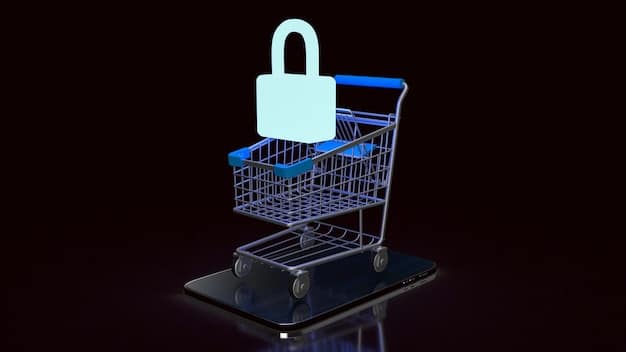E-commerce Platform Security Breaches: Navigating the 2025 US Regulations

E-commerce Platform Security Breaches: Are You Prepared for the Updated 2025 US Regulations? Understanding and complying with these regulations is crucial for protecting customer data and maintaining trust in your online business, avoiding severe penalties and reputational damage.
Are you running an e-commerce platform and concerned about security? The threat landscape is constantly evolving, and with the updated 2025 US regulations on the horizon, now is the time to ensure your business is prepared. Understanding these changes is crucial to protecting your customers and your bottom line.
This article dives deep into the new compliance requirements regarding e-commerce platform security breaches. We’ll explore the key aspects of these regulations, offering practical advice and insights to help you navigate them effectively. Are you really equipped to defend against increasingly sophisticated cyberattacks and maintain compliance?
Understanding E-commerce Platform Security Risks
E-commerce platforms are prime targets for cyberattacks due to the vast amounts of sensitive data they handle, including customer financial information and personal details. A breach can lead to significant financial losses, legal repercussions, and damage to a company’s reputation. Thus, understanding the risks is the first step in mitigating them.
Common Types of E-commerce Security Breaches
Several types of security breaches commonly affect e-commerce platforms. These include:
- Malware Infections: Malicious software can compromise systems, steal data, or disrupt operations.
- Phishing Attacks: Cybercriminals use deceptive emails or websites to trick individuals into revealing sensitive information.
- DDoS Attacks: Overwhelming a server with traffic, making the website inaccessible to legitimate users.
- SQL Injection: Exploiting vulnerabilities in a website’s database to gain unauthorized access.
Understanding these common threats can help businesses better prepare their security posture. Implementing robust security measures and regularly updating systems are vital to protecting against these breaches.

Key Components of the Updated 2025 US Regulations
The updated 2025 US regulations aim to enhance the protection of consumer data and increase accountability for e-commerce platforms. These regulations encompass various aspects of data security, including data encryption, breach notification requirements, and compliance audits.
Data Encryption Standards
One of the critical components of the updated regulations is the requirement for strong data encryption. Businesses must encrypt sensitive data both in transit and at rest. This involves using robust encryption algorithms and maintaining proper key management practices.
For example, implementing AES-256 encryption, a widely recognized standard, can help protect data from unauthorized access. Regular assessment of encryption methods is crucial to ensure ongoing effectiveness.
Breach Notification Requirements
The regulations also mandate strict breach notification requirements. In the event of a security breach, businesses must notify affected customers and regulatory authorities within a specified timeframe. This includes providing detailed information about the nature of the breach, the data compromised, and the steps being taken to mitigate the impact.
Failure to comply with these notification requirements can result in significant penalties and legal liabilities. Therefore, having a well-defined incident response plan is essential.
How E-commerce Platform Security Breaches: Are You Prepared for the Updated 2025 US Regulations?
E-commerce Platform Security Breaches: Are You Prepared for the Updated 2025 US Regulations? This a a critical question that businesses must address proactively. Compliance involves a multi-faceted approach, including implementing robust security measures, conducting regular audits, and training employees on security best practices.
Implementing Robust Security Measures
One of the primary steps in preparing for the updated regulations is to implement robust security measures. This includes installing firewalls, intrusion detection systems, and anti-malware software. Regular security assessments and vulnerability scans are also essential to identify and address potential weaknesses.
Additionally, multi-factor authentication (MFA) should be implemented to add an extra layer of security, making it more difficult for unauthorized users to access sensitive data.
Conducting Regular Audits
Regular security audits are vital for ensuring ongoing compliance. These audits should assess the effectiveness of existing security measures and identify any gaps or vulnerabilities. Internal audits, as well as third-party assessments, can provide a comprehensive evaluation of an e-commerce platform’s security posture.
Audit findings should be used to develop and implement corrective actions to address identified issues promptly.
Steps to Take After an E-commerce Security Breach
Even with the best security measures in place, breaches can still occur. Knowing what steps to take after a breach is critical to minimizing the damage and complying with regulatory requirements. Immediate action to contain the breach, notify affected parties, and conduct a thorough investigation is essential.
Containment and Eradication
The first step after discovering a security breach is to contain the damage. This involves isolating affected systems, preventing further data loss, and preserving evidence. Once containment is achieved, efforts should focus on eradicating the threat by removing malware, patching vulnerabilities, and restoring systems from backups.
A swift and decisive response can help limit the scope of the breach and prevent additional harm.

Investigation and Analysis
A thorough investigation is necessary to determine the cause of the breach, the extent of the damage, and the data compromised. This involves analyzing logs, examining systems, and interviewing personnel to gather relevant information. The findings of the investigation should be documented and used to improve security measures and prevent future breaches.
Engaging with cybersecurity experts can provide valuable insights and assistance during the investigation process.
Training and Awareness for E-commerce Security
Employee training and awareness are crucial for maintaining a strong security posture. Employees should be educated on common security threats, best practices for data protection, and the importance of following security policies. Regular training sessions and awareness campaigns can help foster a security-conscious culture within the organization.
The Importance of Security Culture
Creating a security-conscious culture involves making security a shared responsibility across the organization. This includes educating employees on the importance of secure passwords, recognizing phishing attempts, and reporting suspicious activity. A strong security culture can significantly reduce the risk of human error, which is a major factor in many security breaches.
Ongoing Training and Updates
Security training should be ongoing and updated regularly to address emerging threats and regulatory changes. This includes providing employees with the latest information on phishing techniques, malware threats, and security best practices. Regular assessments can help ensure that employees retain and apply the knowledge gained from training.
| Key Point | Brief Description |
|---|---|
| 🛡️ Encryption Standards | Implement strong data encryption for data in transit and at rest. |
| 🚨 Breach Notification | Have a well-defined incident response plan for timely notifications. |
| 🔒 Security Audits | Conduct regular audits to identify vulnerabilities and gaps. |
| 🧑💻 Employee Training | Train employees on security threats, best practices, and policies. |
Frequently Asked Questions
The updated regulations focus on enhanced data encryption, stricter breach notification timelines, and more rigorous compliance audits to ensure better protection against e-commerce platform security breaches.
Data encryption protects sensitive customer information, such as credit card details and personal data, from unauthorized access in case of a security breach.
The updated regulations mandate that e-commerce platforms must notify affected customers and regulatory authorities within a specified timeframe, typically within 72 hours of discovering the breach.
Non-compliance can result in significant financial penalties, legal liabilities, and damage to the company’s reputation, leading to loss of customer trust and business.
Regular security audits help identify vulnerabilities and gaps in the security infrastructure, allowing businesses to address potential weaknesses before they can be exploited by cybercriminals.
Conclusion
Staying ahead of the curve regarding e-commerce platform security breaches and compliance with the updated 2025 US regulations is essential for protecting your business and maintaining customer trust. By understanding the key components of these regulations and implementing robust security measures, you can mitigate the risk of breaches and ensure ongoing compliance.
Proactive preparation and continuous monitoring are crucial for navigating the evolving threat landscape and safeguarding your e-commerce platform. Continuous improvement and employee education should be part of your on-going processes.





